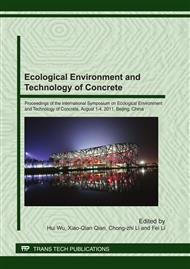[1]
Wang Aiqing, Zhang Chengzhi: Journal of Hydraulic Engineering, China Institute of Water Resources and Hydropower Research, Beijing, China, 2003(2), pp.117-128.
Google Scholar
[2]
Chen Jin, Masoud Soltani, Xuehui An: Computers & Structures, Elsevier, Volume 83, Issues 8-9, March 2005, pp.525-535.
Google Scholar
[3]
China Three Gorges Project Corporation in: Specifications for hydraulic concrete construction", China State Code, China Electric Power Press, Beijing, China, 2002, pp.8-10.
Google Scholar
[4]
Wang Wenlong, Jiang Qingshan: Journal of Irrigation and Drainage, Chinese Academy Of Agricultural Sciences, Henan, China, 2006(3), pp.63-65.
Google Scholar
[5]
Lin Yuqiang, Li Jiazheng, Yang Huaquan: Journal of Yangtze River Scientific Research Institute, Yangtze River Scientific Research Institute, Wuhan, China, 2009(12), p.97.
DOI: 10.18307/2020.0226
Google Scholar
[6]
Li Xiangguo, Ma Baoguo, Luo Zhongtao, et al: Concrete, China Northeast Architectural Design & Research Institute, Shenyang, China, 2006(10), p.59.
Google Scholar
[7]
G.R. Meira, C. Andrade, C. Alonso, et al: The use of chloride deposition rate on the wet candle as an environmental indicator", Cement and Concrete Composites, Elsevier, Volume 32, Issue 6, July 2010, pp.427-435.
DOI: 10.1016/j.cemconcomp.2010.03.002
Google Scholar
[8]
X.G. Hu, A.W. Momber, Y. Yin, et al: Wear, Elsevier, Volume 257, Issues 5-6, September 2004, pp.441-450.
Google Scholar
[9]
Li Jinyu: Ready-Mixed Concrete, Chinese Ceramic Society, Beijing, China, 2005(2), pp.54-60.
Google Scholar
[10]
Yao Xuejian; Wen Guoliang; Fu Xiaoli; et al: Water Resources and Hydropower Engineering, Research Center of Development of Irrigation Works Ministry, Beijing, China, 2008(4), pp.66-72.
Google Scholar
[11]
A.K. Mullick: International Journal of Cement Composites and Lightweight Concrete, Elsevier, Volume 10, Issue 4, November 1988, pp.225-232.
Google Scholar
[12]
Ahmad Shayan, Jack Grimstad: Cement and Concrete Research, Elsevier, Volume 36, Issue 2, February 2006, pp.371-383.
Google Scholar
[13]
Yu-Wen Liu: Construction and Building Materials, Elsevier, Volume 21, Issue 5, May 2007, pp.972-977.
Google Scholar
[14]
Elzbieta Horszczaruk: Wear, 15th International Conference on Wear of Materials, TN, USA, Volume 259, Issues 1-6, July-August 2005, pp.62-69.
Google Scholar
[15]
E. Horszczaruk: Wear, Volume 256, Issues 7-8, April 2004, pp.787-796.
Google Scholar
[16]
Ge Xueliang, Zeng L, Fang Kunhe, et al: Journal of Hydroelectric Engineering, Chinese Society of Hydroelectric Engineering, Beijing, China, 2008(2), p.84.
Google Scholar


